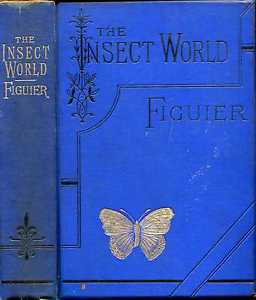Inspiring Older Readers
 posted on 04 Feb 2018
posted on 04 Feb 2018
The Insect World by Louis Figuier
One of the things I most admire about the Victorians was their fascination with all things scientific. I suppose if you were educated, middle-class and not too committed to the extremes of religion it must have been hard not to be thrilled by the new scientific breakthroughs that were happening all the time.
No field of enquiry illustrates this commitment better than the exploration of the natural world which was the obsession of many professional academics and enthusiastic amateurs alike. The detailed observations, classification and cataloguing of flora and fauna seemed ideally suited to the rather finicky Victorian mentality and often it was the hobbyist who made the most significant long term contribution.

As a result of this, books about the natural world were not only popular but often lavishly produced. They were produced not just to record their observations and findings but to be valuable handbooks to aid the explorations of the weekend entymologists. Some of these books sold in huge numbers and ran to several editions in bindings that varied from the luxurious to the functional.
The Insect World : being A Popular Account of the Orders of Insects; together with A Description of the Habits and Economy of Some of the Most Interesting Species by Louis Figuier is originally a French publication translated into Engish in 1872 by P.Martin Duncan. The copy I have picked up isn’t a first edition and is undated but I would guess it’s probably one of the cheaper popular editions that came along in the months following the first printing. The extraordinary descriptiveness of the title clearly shows that the publisher, Cassell, Petter & Galpin were eager to signal that this was an important scientific publication.

I understand that in his native France, Figuier had a reputation as a populariser of science and that this book gained a degree of notoriety because he argued the case for insects being intelligent, sentient creatures – something we might now accept with equanimity but which was a challenging set of ideas for the Victorian public.
But, to be honest, I didn’t buy this book because I had any real interest in reading the text but because it promised 579 illustrations. And it really doesn’t let you down in this respect. The black and white engravings are lovely and so detailed that you don’t really notice the absence of colour – somehow the best kind of engraving can glow in a way that colour can’t. None of the illustrations are credited so I don’t know who the artist was – it may even have been Figuier himself for all I know but I somehow doubt it. This is the work of a skilled artist not a casual one.

I paid a couple of quid for this from a box of junk and it’s given me great entertainment spending some time with the illustrations and admiring the detail. I think modern editions are available and older ones can be found on the second hand market. I doubt I’d have spent more than I did to have this book but now I’ve got it, I love it.
Terry Potter
February 2018
